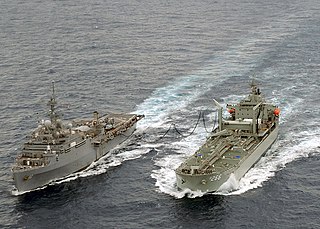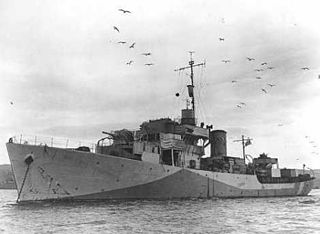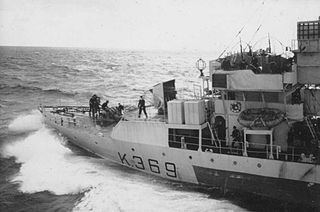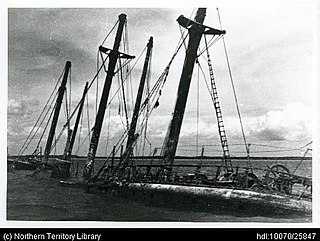
The Royal Navy (RN) is the naval warfare force of the United Kingdom, British Overseas Territories and Crown Dependencies, and a component of His Majesty's Naval Service. Although warships were used by English and Scottish kings from the early medieval period, the first major maritime engagements were fought in the Hundred Years' War against France. The modern Royal Navy traces its origins to the English Navy of the early 16th century; the oldest of the UK's armed services, it is consequently known as the Senior Service.

The River class was a class of 151 frigates launched between 1941 and 1944 for use as anti-submarine convoy escorts in the North Atlantic. The majority served with the Royal Navy and Royal Canadian Navy (RCN), with some serving in the other Allied navies: the Royal Australian Navy (RAN), the Free French Naval Forces, the Royal Netherlands Navy and, post-war, the South African Navy.

Bloxham is a village and civil parish in northern Oxfordshire several miles from the Cotswolds, about 3 miles (5 km) southwest of Banbury. It is on the edge of a valley and overlooked by Hobb Hill. The village is on the A361 road. The 2011 Census recorded the parish's population as 3,374.

HMS Bramham (L51) was a Hunt-class destroyer of the Royal Navy laid down in Alexander Stephen and Sons shipyards Govan, Scotland on 7 April 1941. She was launched on 29 January 1942 and commissioned into the Royal Navy on 16 June 1942. She was named after the Bramham Moor Hunt and has been the only Royal Navy warship to bear the name. She was adopted by the town of Beverley in the East Riding of Yorkshire during the Warship Week savings campaign of 1942.

A replenishment oiler or replenishment tanker is a naval auxiliary ship with fuel tanks and dry cargo holds which can supply both fuel and dry stores during underway replenishment (UNREP) at sea. Many countries have used replenishment oilers.

The Laforey class was a class of 22 torpedo boat destroyers of the Royal Navy, twenty of which were built under the Naval Programme of 1912–13 and a further two under the 2nd War Emergency Programme of 1914. As such they were the penultimate pre-war British destroyer design. All served during World War I during which three were lost; the survivors were all scrapped in 1921-23.

Ships of the Royal Navy is a naval history reference work by J. J. Colledge (1908–1997); it provides brief entries on all recorded ships in commission in the Royal Navy from the 15th century, giving location of constructions, date of launch, tonnage, specification and fate.

The Hunt-class minesweeper was a class of minesweeping sloop built between 1916 and 1919 for the Royal Navy. They were built in two discrete groups, the earlier Belvoir group designed by the Ailsa Shipbuilding Company and the subsequent Aberdare group designed by the Admiralty. They were classed as Fleet Minesweeping Sloops, that is ships intended to clear open water. The Belvoir group were named after British fox hunts. Those of the Aberdare group were originally named after coastal towns, watering places and fishing ports, some of which happened to be hunts by coincidence. However, all were soon renamed after inland locations to prevent confusion caused by the misunderstanding of signals and orders.

The Bangor-class minesweepers were a class of warships operated by the Royal Navy (RN), Royal Canadian Navy (RCN), Imperial Japanese Navy (IJN), and Royal Indian Navy (RIN) during the Second World War.

Adrias was a Type III Hunt-class destroyer that was originally built for the Royal Navy as HMS Border but never commissioned. Before her completion, she was loaned to the Royal Hellenic Navy on 20 July 1942 and commissioned as Adrias on 5 August 1942 in order to relieve heavy losses of ships sustained by the Royal Hellenic Navy during the German invasion of 1941 and throughout the war. Adrias took her name from the ancient Greek town of Adria in Italy, at the mouth of the Po river, after which the Adriatic Sea is named.

The Medea class were a class of destroyers that were being built for the Greek Navy at the outbreak of World War I but were taken over and completed for the Royal Navy for wartime service. All were named after characters from Greek mythology as result of their Greek heritage.

HMCS Long Branch was a modified Flower-class corvette that served in the Royal Canadian Navy during the Second World War. She was used primarily as a convoy escort in the Battle of the Atlantic. She was laid down as HMS Candytuft but was transferred to the RCN on 5 January 1944 before completion. She was named for Long Branch, Ontario, a village that was eventually amalgamated into Toronto, Ontario.
HMS Drury was a Captain-class frigate, originally commissioned to be built for the United States Navy as an Evarts-class destroyer escort. Before she was finished in 1942, she was transferred to the Royal Navy under the terms of Lend-Lease, and saw service during the Second World War. She has been the only ship of the Royal Navy to be named Drury, after Captain Thomas Drury, commander of HMS Alfred in the West Indies in 1795.

HMCS West York was a Flower-class corvette of the Royal Canadian Navy which took part in convoy escort duties during the Second World War. Named after Weston, Ontario, she was built by Midland Shipyards Ltd. in Midland, Ontario and commissioned on 6 October 1944 at Collingwood.

Kelat was an 1894 gross ton iron hulled fully rigged three masted sailing ship built in Stockton-on-Tees, England in 1881. She was requisitioned by the Royal Australian Navy (RAN) in 1941 and sank as a result of damage suffered during the Japanese air raid on Darwin on 19 February 1942.
HMS Halsted (K556), ex-Russell, was a Captain-class frigate of the Buckley class of destroyer escort, originally intended for the United States Navy. Before she was finished in 1943, she was transferred to the Royal Navy under the terms of Lend-Lease, and saw service from 1943 to 1944 during World War II.
SS William D. Bloxham was a Liberty ship built in the United States during World War II. She was named after William D. Bloxham, the Secretary of State of Florida (1877–1880) and the 13th and 17th Governor of Florida.
Polarus Steamship Company was founded in 1918, and again in 1923 in New York City by Tikhon Nicholas Agapeyeff (1891–1931). Tikhon N. Agapeyeff's 1918 firm, operated for only about two years. In March 1921, Agapeyeff sold the first Polarus Steamship Company to the C. M. Fetterolf Company for $250,000. The next incorporation in 1923 was a partnership of Agapeyeff, Marcel Levy, and Charles S. Dunaif. Marcel Levy was an attorney and Charles S. Dunaif was an exporter.
William J. Rountree Company was a steamship agent and broker company founded by William J. Rountree in New York City in 1912. William J. Rountree Company was active in supporting the World War II effort by chartering and operating Liberty ships and Victory ships.













